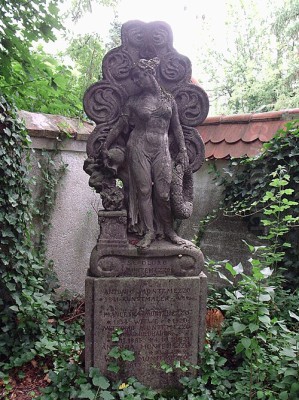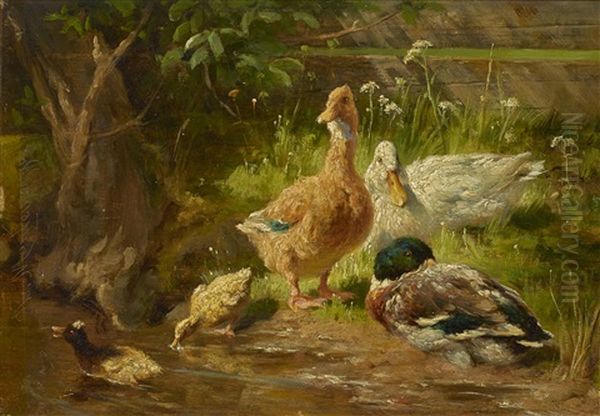
Antonis Matteo Montemezzo stands as a figure representative of the many talented artists of the 19th century who, while perhaps not achieving the global fame of some of their contemporaries, contributed significantly to the rich tapestry of European art. An Italian painter, Montemezzo's life and career spanned a period of profound artistic and social change, from the lingering influences of Romanticism to the rise of Realism and the burgeoning modern art movements. His work, rooted in the traditions of his native Veneto region, also reflects his experiences in other artistic centers, notably Munich, where he spent his final years.
Early Life and Venetian Foundations
Born in 1841 in San Paolo di Piave, a commune in the province of Treviso, Veneto, Italy, Antonis Matteo Montemezzo emerged from a region steeped in an unparalleled artistic legacy. The Venetian School, historically, was synonymous with a mastery of color, light, and atmospheric effects, producing titans like Titian, Veronese, and Tintoretto in the Renaissance, and later, figures like Giambattista Tiepolo in the Rococo period. While the towering achievements of these Old Masters were centuries past, their influence on the artistic identity and training within Venice and its territories remained palpable.
It is highly probable that Montemezzo received his foundational artistic training in Venice, the regional capital and a significant art center. During the mid-19th century, the Venice Academy of Fine Arts (Accademia di Belle Arti di Venezia) was a key institution. Artists like Francesco Hayez, though more associated with Milanese Romanticism, had a period of influence in Venice earlier in the century. More contemporary to Montemezzo's formative years would have been painters who continued the Venetian tradition of veduta (view painting) or genre scenes, often imbued with a romantic or picturesque quality. The emphasis on capturing the unique light and ambiance of Venice, its canals, and its daily life, would have been a cornerstone of any artistic education there.

The artistic environment in Venice during Montemezzo's youth was one of transition. While academic traditions held sway, there was also an increasing interest in realism and capturing contemporary life, a trend seen across Italy with movements like the Macchiaioli in Florence, whose members included Giovanni Fattori and Telemaco Signorini. These artists, though geographically distinct, shared a pan-Italian desire to break from purely academic constraints and engage more directly with the world around them. Montemezzo's own development would likely have absorbed these currents, blending traditional Venetian colorism with newer sensibilities.
Artistic Style and Development
Antonis Matteo Montemezzo's artistic style is noted for its connection to the Venetian pictorial tradition, characterized by delicate colors and soft, fluid brushwork. This approach suggests an artist deeply attuned to the subtleties of light and its interplay with form, a hallmark of Venetian painting throughout its history. His choice of subjects, as indicated by known works, spanned genre scenes and religious compositions, allowing for a versatile application of his stylistic preferences.
The influence of the 19th-century Venetian school is evident. Painters like Giacomo Favretto, a near contemporary, became renowned for their lively and colorful depictions of Venetian folk life, capturing the charm and character of the city and its inhabitants. While Montemezzo's specific interactions are not detailed, the shared artistic milieu would have fostered an environment where such themes and stylistic approaches were prevalent. Another Venetian painter of the era, Guglielmo Ciardi, focused on landscapes and marine views, also emphasizing light and atmosphere, further illustrating the regional artistic concerns.
Montemezzo's later move to Munich, Germany, where he passed away in 1898, places him in another vibrant artistic hub. Munich at that time was a leading center for art in the German-speaking world, home to the Munich School, which was known for its painterly realism, often with a darker palette and an emphasis on draftsmanship, exemplified by artists like Wilhelm Leibl. Prominent figures such as Franz von Lenbach, a celebrated portraitist, and Carl Spitzweg, known for his charming Biedermeier genre scenes, were active in Munich. While it's unclear to what extent Montemezzo assimilated Germanic influences, his presence there suggests an engagement with this different artistic environment.
Notable Works and Thematic Concerns
Among the documented works of Antonis Matteo Montemezzo, a few titles provide insight into his artistic output. "Entenfamilie am Ufer" (Duck Family on the Shore), an oil painting measuring 12x18 cm, dated to 1898, is noted as being in a gallery in Munich. This small-scale work suggests an interest in intimate genre scenes or animal studies, themes popular in the 19th century for their appeal to sentiment and their showcase of an artist's observational skills. The late date of this piece places it at the very end of his life, during his time in Munich.
Other attributed works include "The Birth of Catholicism" and "Christ appearing to Mary Magdalene." These titles indicate Montemezzo also engaged with religious subject matter. Religious painting in the 19th century often navigated a path between traditional iconography and contemporary stylistic trends, sometimes imbuing biblical narratives with a more humanized or emotionally resonant quality. Without viewing these specific works, it is difficult to ascertain Montemezzo's particular approach, but his Venetian background might suggest a treatment rich in color and dramatic lighting, perhaps in the vein of later Venetian religious painters who adapted historical styles to contemporary tastes.
The range from intimate genre scenes like "Entenfamilie am Ufer" to more traditional religious subjects like "Christ appearing to Mary Magdalene" demonstrates a versatility common among artists of the period who needed to cater to different tastes and commission opportunities. His work, therefore, likely reflects both personal artistic inclinations and the broader market demands of the 19th-century art world.
The Broader Artistic Context: Italy and Munich
Antonis Matteo Montemezzo's career unfolded against a backdrop of significant artistic evolution across Europe. In Italy, the mid to late 19th century saw the Macchiaioli movement challenge academic norms with their "macchia" (spot or patch) technique, emphasizing capturing immediate impressions of light and color, akin to early plein-air painting. Key figures like Giovanni Fattori, Silvestro Lega, and Telemaco Signorini were instrumental in this shift towards realism and modern subjects. While Montemezzo's style is described as more traditionally Venetian, the spirit of artistic renewal was pervasive.
Other Italian artists of the period explored different paths. Giovanni Segantini, for instance, developed a unique Symbolist style, often depicting Alpine landscapes with a distinctive divisionist technique. Antonio Mancini, working in Naples and later Rome and Paris, was known for his bold impasto and psychologically insightful portraits. In Venice itself, artists like the aforementioned Giacomo Favretto and Guglielmo Ciardi maintained a strong regional identity, focusing on local scenes and landscapes with a vibrant, light-filled palette. Federico Zandomeneghi, another Venetian, would later move to Paris and become associated with the Impressionists, showcasing the diverse trajectories available to Italian artists.
Munich, where Montemezzo spent his later years, was an equally dynamic art center. The Munich Academy was highly influential, and the "Munich School" of realism, with artists like Wilhelm Leibl and Franz von Defregger, was prominent. The city also attracted artists from across Europe and was a hub for various styles, including historical painting, portraiture, and genre scenes. The presence of artists like Franz Stuck, a key figure in Munich Secession and Symbolism, indicates the city's evolving artistic landscape towards the end of the 19th century. Montemezzo's "Entenfamilie am Ufer" being in a Munich gallery suggests his participation, to some degree, in this German art scene. Contemporaries in the German sphere, beyond those already mentioned, included Max Liebermann, who, though based in Berlin, was a leading figure in German Impressionism and had connections to Munich.
Later Years and Legacy
Antonis Matteo Montemezzo passed away in Munich in 1898. His relocation from Italy to Germany reflects a pattern seen with many artists of the era who sought opportunities, training, or different cultural environments beyond their native lands. The fact that one of his last known works was created and housed in Munich suggests an active artistic life even in his later years.
While Montemezzo may not be as widely recognized as some of his Italian contemporaries like Giovanni Boldini, whose flamboyant portraits captured the Belle Époque, or the pioneering Macchiaioli, his work contributes to our understanding of the diversity of 19th-century Italian art. He represents a strand of artists who, while perhaps not at the forefront of avant-garde movements, maintained and adapted regional artistic traditions in a changing world. His connection to both the Venetian school and the Munich art scene makes him an interesting case study of artistic exchange and adaptation in late 19th-century Europe.
The survival of works like "Entenfamilie am Ufer" and the records of his religious paintings allow art historians to piece together a picture of an artist skilled in the Venetian tradition of color and light, who applied these talents to both intimate genre subjects and more traditional religious themes. His art serves as a reminder of the many individual talents that formed the rich artistic ecosystem of the 19th century, an era that laid the groundwork for the radical departures of modern art in the 20th century. Further research into auction records and gallery archives, particularly in Italy and Germany, may yet reveal more about the oeuvre and career of Antonis Matteo Montemezzo, offering a fuller appreciation of his place within the artistic currents of his time. His life and work underscore the enduring appeal of regional artistic identities even as artists increasingly navigated a more international European art world.